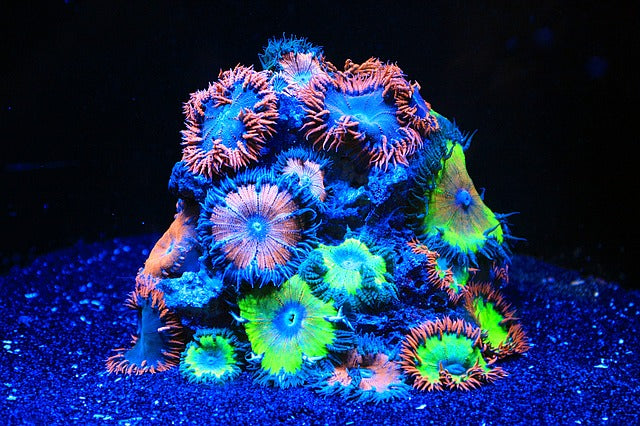
Keeping Corals: How to care for Zoanthids
Whether you are a novice Coral keeper or an experienced reefer, Zoanthids (commonly known as Zoas), are renowned for their easy care, quick growth rate and bright colours. Any marine aquarium can benefit from the addition of these beautiful corals.
| Family | Zoantharia |
| Order | Cnidaria |
| Tank Placement | Low to Mid |
| Care Level | Easy |
| Salinity | 1.026 |
| pH Level | 8.0 - 8.4 |
| Temperature | 26 °C |
| Coral Type | Soft |
What Do Zoas Look Like?
There are four main types of Zoanthid coral formations that tend to be found in the aquarium hobby: Palythoa, Protopalythoa, Zoanthus & Parazoanthus. What we see as one unit, is actually a colony of Zoa polyps that have joined onto a structure to strengthen their bond, and this makes them able to withstand external environmental forces.
Zoas are generally brightly coloured. They are widely available in a broad spectrum of colours which can truly transforms the landscape of any marine aquarium. Although there are hundreds of potential varieties of Zoa presentation combinations, generally, each polyp disc will have some colour towards the centre with the tentacles extending away slightly duller. Whilst the actual polyps only reach sizes of up to about an inch, the colony can spread quickly throughout the tank, for an unlimited range. Unlike other colonising anthozoans or soft corals, Zoas create their structure with the materials surrounding them in their tank such as bits of rock, sand or even equipment. They often colonise rocks quickly and will give a bare looking tank a new lease of life.
Zoanthid Lighting
Zoas are extremely tough and are capable of growing in many locations within an aquarium. They are not fussy and will more or less thrive wherever they are placed, providing the flow is not overly strong.
To tell if a Zoa is happy where it has been placed, they should be open and extended, without being overstretched. The colour of the polyps is also a good indicator with regards to how content the Zoa is in its location. Zoas placed in brighter areas of a marine aquarium will often be more vibrantly coloured. Likewise duller polyps may be an indication of less adequate lighting.
What Do Zoas Eat?
Zoas rely heavily on photosynthesis for their food supply. They get most of their nutrients indirectly from light. Therefore it is important to provide adequate lighting for a marine aquarium housing Zoas. We really like the marine aquarium lighting by Aqua Illumination and get some incredible results by using it above our Zoa colonies and frags.
They are partial filter feeders and will source additional nutrients by filtering through any leftover food in the aquarium. You can also target feed Zoas, by breaking down frozen zooplankton into the water, which they will gradually absorb. This can be done in the aquarium as a whole or directly onto the Zoas using a pipette. This is often a good idea when keeping larger Zoa gardens in order to keep them looking pristine. They can be fed up to 2-3 times a week.
Are Zoas Dangerous?
Although the majority of Zoas are harmless, there are several species which carry one of the most dangerous toxins found in marine life: Palytoxin. It is thought that the Zoas themselves may not produce the Palytoxin, however it may come from a bacterium which inhabits the polyps. Either way care should always be taken when handling ALL types of Zoas.
You should need handle Zoas with an open cut, or touch your face/eyes without washing your hands first. To minimise the risk you should wear suitable protective gloves and try to avoid species that are known to contain Palytoxin which we will detail below:
- P. texaensis
- P. mammillosa
- P. gradis
- P. caribbea
- P. nigricans
If you are not sure what species of Zoa you have, use precautions just in case as even the smallest quantity of Palytoxin can cause paralysis.
Complete Koi and Aquatics are stockists of some amazing Zoa colonies and gardens. They are fantastic soft corals for all levels of aquarium hobbyist.
If you have any further questions on how to care for your Zoanthids, don’t hesitate to get in touch with us. We offer free water testing services to aid your success.
Give us a call or pop over to see us today.